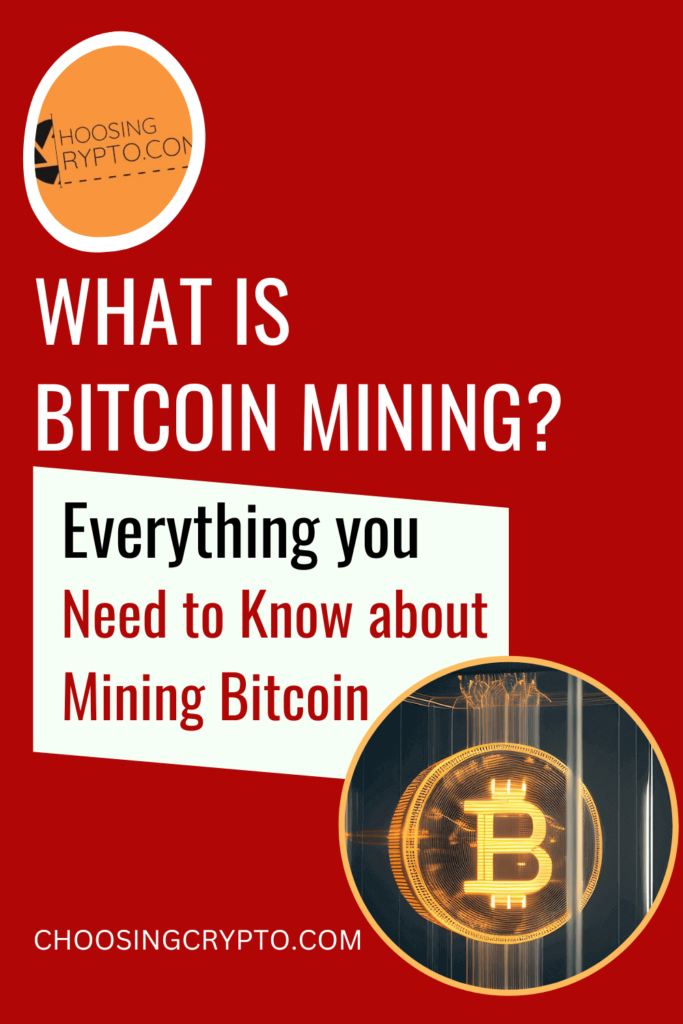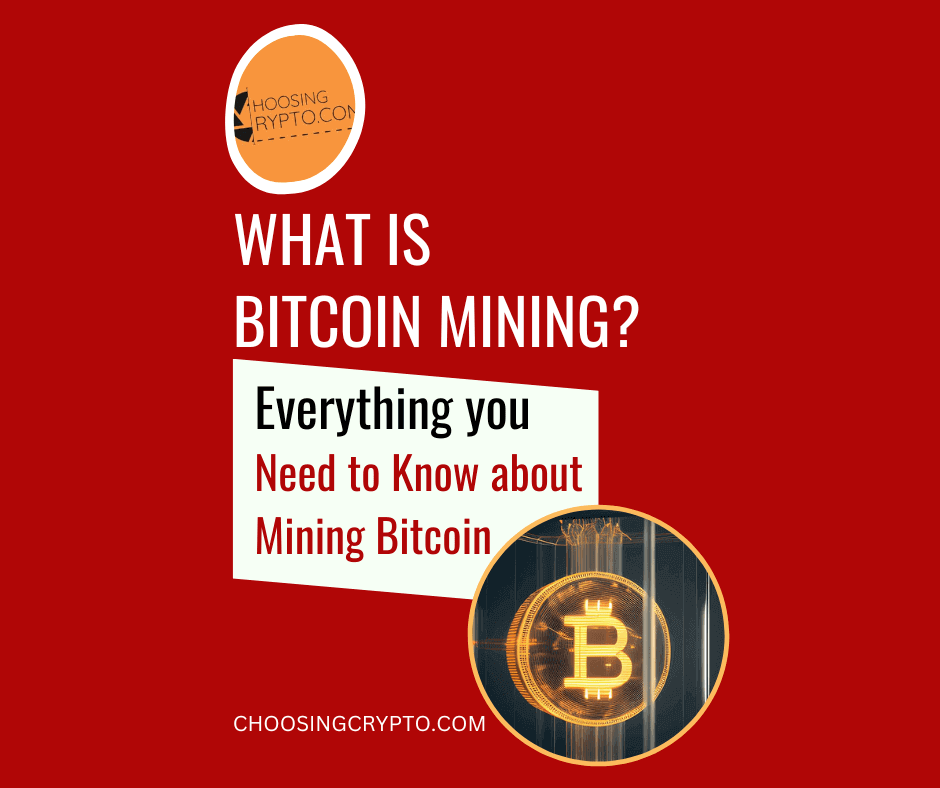Bitcoin mining might seem like an easy way to make money, but it’s not. It’s complex and requires significant technical expertise.
With crypto headlines flashing stories of overnight success, it’s easy to assume mining is your golden ticket to wealth. But before you invest in expensive equipment, you need to know what you’re getting into.
Knowing the full picture can save you time, money, and frustration later.
This guide will walk you through how Bitcoin mining works, what equipment you’ll need, and whether it’s still worth it today.
New to crypto? I offer beginner-friendly 1-on-1 coaching, and your first session is free. Check it out here.
What is Bitcoin Mining?
Bitcoin mining is the process that keeps the Bitcoin network running and secure. It’s how new Bitcoins are created and how transactions are verified and added to the blockchain.
Miners use special hardware to compete to solve complex mathematical puzzles. The first to solve one gets to add a new block of transactions to the blockchain. As a reward, they earn newly created Bitcoins plus transaction fees.
Because no central authority controls Bitcoin, mining helps the system run smoothly and fairly by allowing anyone with the right equipment to participate.
This process is based on a system called Proof of Work.
How Does Bitcoin Mining Work?
Here’s a simple breakdown of how Bitcoin mining works:
1. Transactions are collected
When people send or receive Bitcoin, those transactions are grouped into a block waiting to be added to the blockchain.
2. Miners compete to solve a puzzle
Miners use powerful computers to solve a complex mathematical puzzle tied to the block. This puzzle, called a cryptographic hash function, takes serious computing power and energy.
3. First to solve it adds the block
The first miner to solve the puzzle gets to add the new block to the blockchain. This is called “finding a block.”
4. Other miners verify the block
The other miners check the solution to make sure it’s correct. If valid, the block becomes a permanent part of the blockchain.
5. The miner gets a reward
The winning miner earns a block reward (newly created Bitcoin), plus the transaction fees in that block. Then the process starts again from the beginning.
Why is Bitcoin Mining Important?
Bitcoin mining matters for several key reasons:
1. Creating new bitcoins
Mining is the only way new Bitcoins are created and added to the network. Bitcoin has a maximum supply of 21 million Bitcoins, and once all are mined (expected around the year 2140), no new Bitcoins will be created.
2. Verifying transactions
Mining is how Bitcoin transactions are confirmed. By solving complex mathematical puzzles, miners ensure that transactions are valid and add them to the blockchain.
3. Maintaining network security
Mining protects the network. To alter the blockchain, an attacker would need over 50% of the total computing power, an impossible feat. This high barrier helps keep the network secure.
4. Incentivizing participation
As mentioned, miners earn rewards in the form of newly created Bitcoins and transaction fees. These incentives encourage people to invest in hardware and help maintain the network’s stability.
You May Like: Top Ways to Make Money in the Crypto Market
The Current Reward for Bitcoin Mining
Back in 2009, when Bitcoin started, miners earned 50 Bitcoins for each block they added to the blockchain.
But Bitcoin’s creator, Satoshi Nakamoto, designed the system to reduce rewards over time. So after every 210,000 blocks or roughly every four years, the reward is cut in half. This is called a “Bitcoin Halving.”
The last halving happened in April 2024, dropping the reward from 6.25 to 3.125 Bitcoins per block. The next halving is set for 2028, to cut the reward further to 1.5625 Bitcoins.
This controlled supply keeps Bitcoin scarce, aiming for a maximum of 21 million coins.
Besides block rewards, remember that miners also earn transaction fees. These extra earnings give miners more reason to keep the network running strong.
What Will Happen When 100% of Bitcoin is Mined?
Once all 21 million Bitcoins are mined, around the year 2140—no new Bitcoins will be created.
Miners will no longer earn block rewards but will still earn transaction fees for validating transactions.
At this point, since no more coins will be produced, the only way for people to get Bitcoins will be by buying from existing holders.
Bitcoin’s halving process gradually reduces rewards to prepare for this shift, encouraging miners to rely on fees.
This ensures the network stays secure and operational even after all Bitcoins are in circulation.
Equipments That Are Needed for Bitcoin Mining
Here’s a breakdown of everything you need to start mining Bitcoin:
1. ASIC miner
To mine Bitcoin today, you need specialized machines called ASICs (Application-Specific Integrated Circuits). This is the main machine that does the mining work. ASICs are super-powerful devices made only for Bitcoin mining. Examples are Bitmain Antminer S19 Pro and WhatsMiner M30S.
2. Cooling system
Mining machines get very hot. Overheating can damage the equipment or reduce efficiency. Cooling system options include industrial fans, air conditioning, etc.
3. Mining software
This is the software that will connect your hardware to the Bitcoin network (or a mining pool). Examples are CGMiner, BFGMiner, or software provided by the ASIC manufacturer. No software, no mining.
4. Stable internet connection
You don’t need super fast internet, but it must be stable and consistent. Your miner has to stay connected to the Bitcoin network or mining pool 24/7 to do its job.
5. Reliable power supply
Mining machines consume a huge amount of electricity. You’ll need a strong, compatible PSU to power the mining hardware safely and effectively. Without electricity, your ASIC won’t turn on.
6. Crypto wallet
This is where your mining rewards go. A crypto wallet will help you receive and store your earned Bitcoin. Options include hardware wallets (like Ledger or Trezor), mobile wallets, or even crypto exchanges like Binance, Bybit, or Gate.io. Without a wallet, you can’t receive the rewards you earn from mining.
7. Electricity monitoring equipment (optional)
This will help track your power consumption and calculate profitability. Knowing you’re not spending more on electricity than you’re earning is important.
8. Mining pool account (optional but smart)
Mining solo is difficult. By joining a mining pool, you combine your resources with other miners and share the rewards.
New to mining and don’t know where to start? I’ll help you choose the right tools, avoid mistakes, and set up properly. First coaching session is free. Start here.
Is it Too Late to Start Bitcoin Mining?
Wondering if you’ve missed the opportunity when it comes to Bitcoin mining? It’s true, early miners made big profits when things were simpler and competition was low. But that doesn’t mean it’s too late to start.
Mining today is tougher. It’s no longer something you can do on a regular computer. You need ASICs—specialized machines that are fast but use a lot of power. High electricity costs can eat into your profits fast.
Rewards have also dropped. Remember every four years, the reward per block is cut in half. That means you’re earning less for the same effort compared to the past.
Still, it’s not too late, if you treat it like a real business. With the right hardware and access to cheap electricity, there’s opportunity. But this isn’t a side hustle anymore. It takes planning, investment, and smart choices.
Harder? Definitely. But not too late.
Additional Resources:
- 10 Facts About Bitcoin You Might Not Know
- What Exactly is Bitcoin and How It Works
- 7 Common Mistakes Crypto Investors and Traders Make
And guess what? We’re also on Instagram and X (Twitter). Join us there for even more fun and useful content!

DISCLAIMER:
The information provided here is for informational purposes only. Do not rely solely on it for making investment decisions. It is not financial, tax, legal, or accounting advice. Always do your own research or consult a financial advisor before investing in cryptocurrency.
